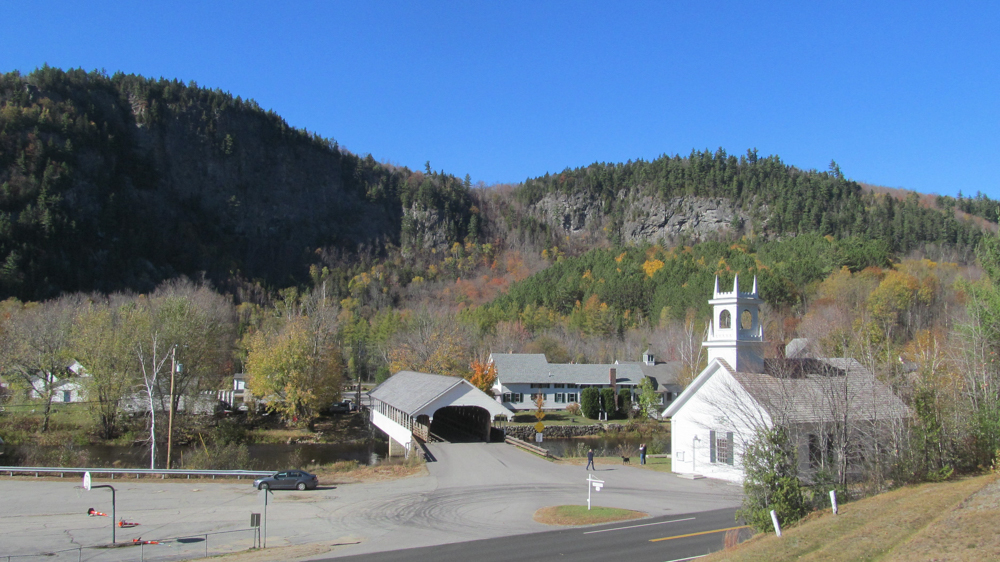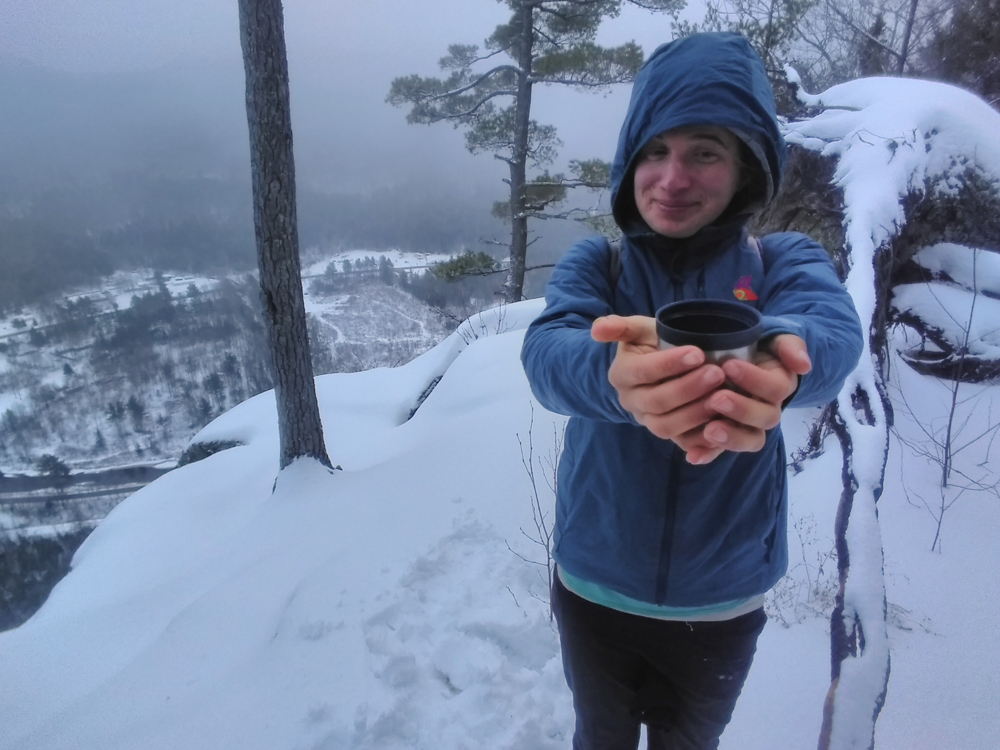Devil’s Slide rises almost 800 feet above my boyhood hamlet of Stark. As a child the deciduous forest that stretched northward across the railroad tracks from our house felt immense. The Slide’s tall, rocky precipice was the gateway and the woods at its base were etched into my boyhood mind; I knew them like the back of my hand. I could cross Canadian National’s steel rails and wander in the Great North Woods’ boreal forest all the way up to Dixville Notch if I had wanted. As the crow flies that number is a paltry 19 miles; for the boyhood wanderer, up that 100 times. Today my adult legs and concept of space make that nineteen miles feel smaller, but in my youth I didn’t “know” that number.
Almost a decade had passed since I had been to Stark in non-winter months, so when I made the journey in 2020 for my mother’s 75th birthday I took the opportunity to visit an old stomping ground and reacquaint myself with the eastern, hardwood dominant, forest. After a mile road walk I turned into a gravel pit, mostly grown over with saplings draped in orange and red leaves, and wandered on a not that far retired logging track up into and through some clearings. I trod over the leaves and acorns of the long forgotten oak, pocketing some of the yellow, deeply cleffted leaves, and the hard round, unsown seeds to bring back to Andy as a reminder of home. The memories of the trail that I had cut through the trees decades ago were mere shreds, but here and there I caught senses of déjà vu. The trail of my youth had cut up into the pines just west of the railroad crossing. It crossed an open meadow of Frizzell’s Field and then up an old sapling carpeted logging road. It contoured west then curved up, around, and climbed to the cliff tops, around the same place as the current Forest Society trail. And of course the memories came flooding back and a slideshow ran through my mind.
It was my playground and it saw me through all my ambitions; it was my giving tree. In the early days I would dress in various styles of camoflauge (red, jungle, winter, urban, etc) or olive drab military clothing, grab some assemblage of homemade weapon

s and run into the woods to shoot various terrorists, communists, and general evil doers. Of course I had, at that age, never watched “Red Dawn” but that didn’t mean I didn’t know the premise. I played the games. My grandpa Kelly had made us wooden guns; he took an outline of a rifle stock and ran it through a bandsaw and then attached a dowel “barrel” with some electrical tape and a thin metal trigger guard with tiny nails. My brother and I each had one with which we walked through the woods and hunted. Not longer after, I added a pistol grip and long, curved magazine, turning it into an automatic, machine gun style rifle. I would load a small backpack with wooden pistols, tennis ball hand grenades, and various military equipment crafted from scrap wood and pictures in our Encyclopedia Britanica, then venture across the tracks to set booby traps and protect freedom. I think if I were in school today, I would be flagged and be talking to counselors.
Winters would have us sledding on the hill by the red house, an old, long since demolished, two story house that was uninhabited and sat 100 yards up a birch and maple lined dirt driveway from the railroad. Peering through the windows at the unused, furnished bedroom, with old pictures on the wall always made my spine shiver. We would drag and carry our various sledding implements up the driveway, eager for adventure. From wee bobbing in elementary school gym classes to trying to “snowboard” by standing on our blue plastic sled to recreating the 1988 Calgary Olympic bobsled and luge runs there were plenty of things to keep us entertained and mostly out of trouble.
As the years progressed I evolved to traipsing through the swamp, skiing or snowshoeing on our neighbor’s snowmobile trail, or building fires and boiling water, just to see if I could. At the red house, staying low meant the swamp, staying high meant trending eastward toward Percy. Somewhere on the snow machine trail to Percy, a small spur led down to my best friend Jake’s house. Somewhere in that mixed stand of conifers and maples, beeches, and oaks there was a small three sided lean-to someone had built. It wasn’t cobbled together like us kids would have done; it was built on concrete pillars with two by fours, panel board siding, and a shingled roof. Whose property it was I don’t think I ever knew, but Jake and I would go up there and build fires in the winter. We smoked a few long, white, Now 100 cigarettes that I had lifted off the old man and we even tried smoking thinly rolled birch bark; the thought of its thick, black, acrid smoke still hurts my lungs. In the college years, I would cross the tracks and make a beeline toward the center gully on Devil’s Slide, my new SMC ice axe in hand, crampons in my pack, and a bunch of eagerness to put them to use on an ascent of the treed gully. By then I had traded the campfires for a small pot and the Peak1 Feather 400 stove and would make hot chocolate or Cup-A-Soups.

Through the years, the creation of Devil’s Slide State Forest, the Kaufman Forest, and the Percy State Forest helped preserve this wild region from development just as the earlier the Nash Stream State Forest did the same. In my childhood though, I never really knew who owned it. I never would have thought twice, at least not with empathy, about the Wabanaki and Abanaki peoples(1) or that in 1759 Roger’s Rangers attacked the village of St. Francis in Southern Quebec “annihilating nearly the entire Indian stronghold and . . . humbled the Abenaquis tribe, which effectively opened the way for English settlers to move northward(2)” and in effect, settle the lands in region.
Today, even with twenty years mountain stomping beneath my boots, my mind can’t begin to compute the actual height of the cliffs; GoogleEarth however, gave me a rough estimate of 350-500 feet on the longest parts of the face. The remnants of an ancient ring dike, Devil’s Slide is primarily made up of hornblende syenite, a, geologically speaking, relatively uncommon rock(3). Syenites are a type of plutonic igneous rocks, which have been quarried for millenia near the ancient Egyptian city of Syene—which today is known as Aswan(4). These stone quarries helped construct the massive shrines, statues, towers, and pyramids that are still found throughout Egypt(5). To be clear though, no Egyptian slaves ever carried or carved rock from Devil’s Slide; no monuments to egos were ever created from its stone. Even after my introduction to rock climbing, it never really looked that appealing; it didn’t have the classic texture and composition of the nearby Roger’s Ledge or other regional “Conway Granite”. One of our younger neighbors, Danny, had an old rope and I remember setting up some sort of rappel with him up on a small tree shrouded cliff—we may have even climbed a mossy groove. And I may have walked the bottom of the face once, but even to my then untrained eye, something climb-able seemed dubious.
In the mid 90’s astute avian observers noted the presence of peregrine falcons (Falco peregrines) on the slide’s sheer cliffs. The craggy, undisturbed nature of the cliff made it a perfect home for a bazaar of the raptors. I heard tell of these nesting birds of prey and scanning the cliffs with binoculars trying to locate the scrape (nest). Peregrine falcons, like most falcons, do not build typical nests, but instead lay their eggs in scrapes, or small depressions. These scrapes are made in the soil or gravel of a cliff ledge, though sometimes abandoned stick nests of other species are used(6). The NH Audobon Society had partnered with the NH Fish and Game to manage the then threatened species and somehow I got the task of taking biologist Chris Martin and a group of ornithologists/rappelers to the cliff top above the nest. While they rappelled down to band the nestbound chicks, I, and several others, used brooms and branches to keep the dive bombing parents at bay. Removed from the federal endangered species list in 1999 and from the NH list in 2008, the peregrine has now made a solid recovery in numerous corners of NH’s infrastructure and cliffs.
We weren’t the only ones who hiked and camped up there over the years. The occasional hoots and hollers that are required when summiting or coming upon a cliff would occasionally drift down on the airways. It is almost an innate need to yell and show the world your presence when you step to the edge, when you step to the top. From time to time we would see a tent or a fire somewhere along the cliff line. My Kelly cousins, dad, Uncle Rusty, and myself hiked up there and spent the night once and at an earlier time, my brother and I, along with our cousin Mark made a day trip to the top. Mark built a fire and I felt in awe. One, he had a lighter and two, he took off his shirt and used it to fan the fire, which roared with the heaped on dead pine boughs. It felt rebellious and I felt scared. I had never felt that level of independence. I am pretty sure I lingered afterwards to be sure every piece of the coals were stomped out; I was sure we would start a forest fire and get busted.
Somewhere in that web of years, Josh remembers it as the summer ’93, an abandonded campfire did start a forest fire up there. It smoldered and burned on the east, lower part of the slide, somewhere up the road, beyond Jake’s house. It was uncertain and scary and Josh and I were recruited to help quell the fire. I staggered under the weight of five gallons of water strapped to my back in a metal tank; the wide, unpadded nylon straps cut deep depressions into my scrawny, boney shoulders. In my hand was a metal pump attached to a rubber hose and we would use the hose and pump to drain the tanks onto hot spots that smoldered on the ground. Numerous trips up the hill from the incidnet command didn’t make the load carrying any easier.
Then I left. And I didn’t come back to that giving tree and fertile ground for a long time. The red house was torn down, the land was purchased and donated by a philanthropist, trees were logged, friends moved away, people passed on, and trails were moved, used, and forgotten. Someone even bolted a climb or two on the eastern cliffs. Life happened but the forest and ancient rim dike remained.
Now, twice in as many years, I have climbed the steep northwestern slopes to the wooded overlooks. After hiking in the fall of 2020, I shared the place with Andy in December of 2021. We walked the requisite mile of pavement with lumps of dirty snowbanks and brown grass piled off to the side. We paralleled the river and talked of place. Our ascent up the northwest side took us over the crunchy, snow covered forest floor and through the grey, lifeless, brown leaf clad beeches and snow laced conifers. Our ascent offered little in the way of excitement; temperature, terrain, timing: they all seemed appropriate. It was a simple, late afternoon jaunt that we took seriously enough to bring our headlamps and some tea, snacks, and layers, but it is fair to say, underestimated the descent

After sharing tea and a fig newton at the top we decided to go for a loop. “We can descend the middle” I said; Andy agreed, I was the local expert after all. We postholed through the crusty snow, over and around small rocky steps, slipping and sliding through the conifers that carpeted the rounded top. A windstorm, two or three years prior, had up rooted a number of trees creating a pickup stick nature to our travels. As we neared the intersection of our descent route and the setting sun, the appoligies that come with my nervousness and uncertainty began to bubble upward. “Should be around here” and “just up here we will drop that way” I started saying as we left the cliff top and zigzagged through the rough, grey trunks of the maples and oaks. After both collapsing some false ground and dropping up to our groins in a hidden hole, we reached the top of our descent gully. The college years never would have seen me come up here in the winter with out an ice axe or crampons, but hubris had me believe we could work it out through route finding or maybe, and more likely, I simply forgot that the terrain was steep and didn’t realize that the snow would be so thin, not allowing for a solid plunge step. We slid, stepped, and leaned down the slope, tree to tree, using branches, handjams, and small rocks as holds for feet, bodies, and hands. The hard frozen leaves and dirt, thinly veiled by snow, gave little hope of secure footing. We spotted and pointed and dug out rock holds and inch by inch creeped down the quickly darkening slope. As the angle lessened, we donned headlamps and kept pointing our toes across the hill, before intersecting a swath like trail. My boyhood memory took over and it told me go left and uphill slightly. The swath deposited us in the clearing above the red house; Andy and I had skied through there the year before and decades prior numerous commies had succumbed to freedom on that small battlefield.
My mind was elsewhere and maybe my heart too, but our adult legs made short work of the snow covered walk home.
Featured Image: The view from the campsite at the top of Devil’s Slide
Author’s Note: This piece is dedicated to Andy—thanks for helping me discover a love of place; thanks for asking the questions that build the stories; thanks for stretching me.
1: https://native-land.ca
2: Stark Bicentenial Committee, History of Stark New Hampshire (Littleton, NH, Courier Printing Co, 1974), p.3
3: https://geologyscience.com/rocks/igneous-rocks/syenite/
4: https://geologyistheway.com/igneous/syenite/
5: https://en.wikipedia.org/wiki/Aswan
6: https://www.peregrinefund.org/explore-raptors-species/falcons/peregrine-falcon

Be First to Comment